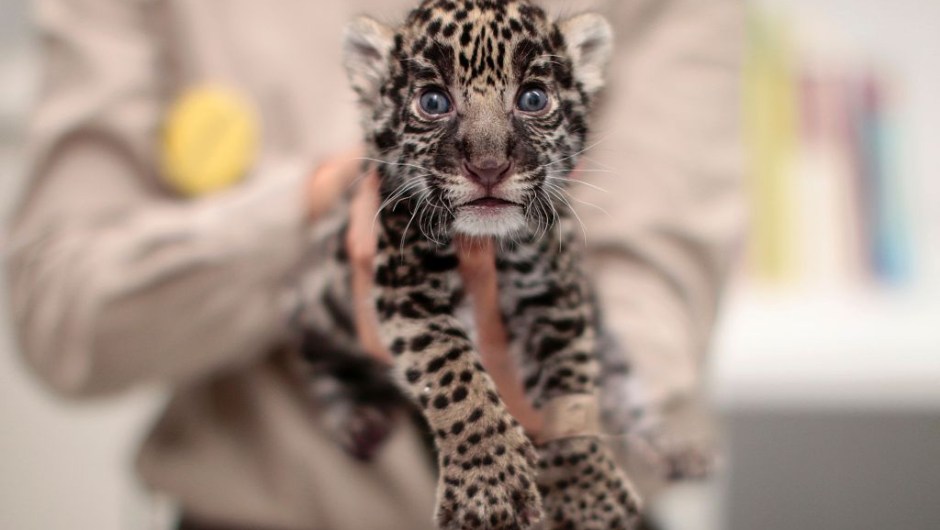Adorable jaguar babies are born in Mexico zoo 0:44
(CNN Spanish) -
Did you know that jaguar spots are unique to each specimen and therefore function like our fingerprints?
And that its jaw is so powerful that it can pierce the shell of a tortoise?
This Monday, November 29, the International Day of the Jaguar, the king of the American cats, is celebrated.
We propose you to know 10 key facts about this iconic species in the region, which is threatened by habitat loss and has already disappeared from a large percentage of the territory.
The third largest feline on the planet
The jaguar is the largest feline — and the fiercest predator — on the American continent.
And it is also the third largest in the world: surpassed only by the Tibetan tiger and the lion.
According to WWF Colombia, it is the only one of the genus
Panthera
in the region.
The
Panthera
are characterized by roaring, explains the organization.
How it sounds?
Like "repetitive snoring", according to WWF.
Name of Tupí-Guaraní origin
advertising
The name of the jaguar, also known as yaguaraté, comes from the Tupí-guaraní "yaguara".
It means "one who hunts with one leap."
'Umbrella species'
The jaguar can inhabit multiple ecosystems, including tropical forests and savannas, montane forests, and mangroves.
Their preferred habitat, however, is the tropical lowland forests and subtropical forests.
In these places, explains WWF Mexico, it finds an "enormous abundance of animals and plants, as well as water."
And their presence is key for ecosystems to remain healthy for two reasons, explains the WWF: on the one hand, being the largest predators on the continent, they regulate the sizes of populations of other animals.
On the other hand, as they need large portions of territory to develop, they are an "umbrella species", that is, "a species that, when protected, conserves the habitat of hundreds of other species that share their home."
"In other words, if the jaguar is healthy, its ecosystem and the rest of the species that live there are," explains the organization.
Can pierce a shell
The jaw of the jaguar is the most powerful of all felines, according to WWF, and can pierce the shell of a tortoise.
Another difference with their relatives is in their behavior
The stains are your 'fingerprints'
Jaguar spots are unique to each individual, which is why they function like human fingerprints, explains WWF Colombia.
And in these spots, which are also called rosettes, is the key to differentiate jaguars from leopards (which, on the other hand, inhabit parts of Africa and Asia): jaguar rosettes enclose another spot inside, explains Greenpeace.
Can you spot it in the pictures?
The figures that define the jaguar
The jaguar weighs between 45 and 120 kg and measures between 1.5 and 2.4 meters, according to WWF Mexico.
Sizes vary by region: in South America they are larger than in Mesoamerica.
The gestation period lasts 100 days.
Females, in general, have two young, who spend with them until one and a half or two years, age at which they reach sexual maturity.
They live for 10 to 12 years when found in the wild.
A last figure gives the pattern of the life of this feline: they eat more than 22 species of animals, including mammals, birds, fish and reptiles.
(Credit: YJ Rey-Millet / WWF)
From the oldest fossil of a feline to the current jaguar: an ancient history
The first fossil of a feline ancestor is more than 25 million years old and was found in Laugnac, France, according to WWF Colombia.
The Panther family, meanwhile, was born about 6.4 million years ago, and the "closest" ancestor of jaguars in the Old World dates back to at least three million.
"This ancestor traveled through almost the entire territory and when the transcontinental dispersal between Asia and North America occurred, approximately 0.9 million years ago, the jaguars stayed in the American continent, becoming the kings of the entire region," they explain.
They disappeared from half of the territory they inhabited
The jaguar is classified as "near threatened", according to the Red List of Threatened Species of the International Union for Conservation of Nature (however, in some particular countries, for example Mexico, it is listed as endangered).
"The jaguar has been practically eliminated from much of the drier northern parts of its range — Arizona and New Mexico in the United States, and the extreme north of the state of Sonora in Mexico — as well as from northern Brazil, the Pampas scrub grasslands of Argentina and all of Uruguay, "says the organization.
According to WWF Colombia, so far jaguars have disappeared from 46% of the territory they originally inhabited.
The threats that this feline faces as a result of the intervention of humans in its natural habitat are multiple: illegal trafficking, mining, logging and the expansion of the agricultural frontier are some of them.
1 of 7
|
On November 29, the largest feline in America is celebrated.
Here we tell you why it is so important to save it.
(Credit: PEDRO PARDO / AFP via Getty Images)
2 of 7
|
The jaguar is the third largest feline in the plant and the fiercest predator in America.
However, the jaguar is at risk and faces increasing threats.
(Credit: YJ Rey-Millet / WWF)
3 of 7
|
Due to the growth of the agricultural frontier, mining and logging, jaguars have disappeared from 46% of their original territory.
(Credit: Pablo Beah / WWF)
4 of 7
|
Illegal trafficking and conflicts with humans have also caused jaguar populations to continue to decline.
(Credit: CONICET / WWF)
5 of 7
|
In fact, the jaguar is extinct in El Salvador and Uruguay.
In the rest of America the species its populations are decreasing.
(Credit: MEHDI FEDOUACH / AFP via Getty Images)
6 of 7
|
The jaguar is a key species since in addition to regulating the populations of other animals, it conserves the habitat of hundreds of other species that share its home.
(Credit: MEHDI FEDOUACH / AFP via Getty Images)
7 of 7
|
That is why if the jaguar is healthy, its ecosystem and the rest of the species that inhabit it are also healthy.
(Credit: MEHDI FEDOUACH / AFP via Getty Images)
There is a plan to save it, but it is missing, says WWF
The Jaguar 2030 Plan has been underway since 2018. WWF Colombia explains that this roadmap with directives to protect the species was ratified by 14 of the 18 countries where the feline lives.
Several organizations are also participating in the effort.
The plan seeks to strengthen the jaguar corridor through various actions, for example establishing 30 landscapes that are priorities for conservation by 2030 with the aim that they have the necessary habitat to develop.
However, WWF Colombia assures, "strong actions are still lacking to strengthen the jaguar corridor that extends from Mexico to Argentina."
5 actions to take care of the jaguar
There are several actions we can take to protect America's king of felines.
Here we tell you five that WWF Guatemala highlights:
Do not participate in any jaguar hunting activity.
Do not buy fur from this feline, or medicinal products or souvenirs that are made with parts of their bodies.
Report wildfires and avoid building fires in jaguar habitats.
Avoid furniture with exotic woods such as cedar or mahogany when they are not certified because, according to the organization, "the Mayan jungle, habitat of the jaguar, is being destroyed to obtain precious woods."
Do not throw garbage in streets or natural areas, since it can reach the habitat of the jaguar through rivers and lakes.









